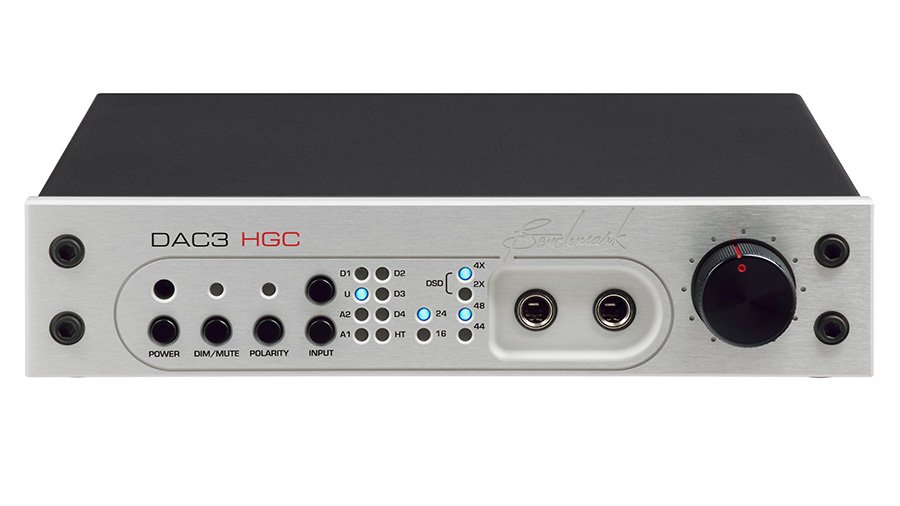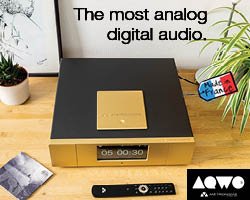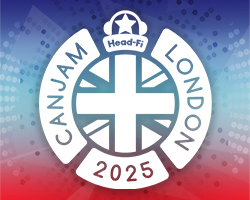DAC3 is the latest converter to be unveiled by Benchmark and features the new ESS Technology ES9028PRO chip. Dan Worth takes the £2349 American made DAC3 for a test drive.
For the past few months during initial measuring and listening tests, which Benchmark report were extremely impressive, they decided to create a new product family building on the success of the previous DAC2 HGC (with included headphone amplifier) and DAC2 L (without headphone amplifier), the two new products fall directly in line – DAC3 HGC and DAC3 L, which are some of the very first products to include the new ESS chip.
The architecture of both the ES9018 and ES9028PRO seem very similar to the trained eye but for those of us without the more technical mindset, here are four of the main advantages to the new converter:
- THD Compensation
- Improved oversampling filters
- Improved phase locked loop
- Improved power supply distribution
Of these, Benchmark considers the THD compensation the most clever and unique feature. The improved filters deliver a slightly flatter frequency response. The improved phase locked loop allows virtually instantaneous switching between digital inputs. The improved power supply distribution contributes to the effectiveness of the THD compensation by minimising THD-inducing interactions between the various subsystems.
Benchmark say: ‘This 32-bit digital processing block compensates for the THD produced by the analog outputs on the chip. It can also be adjusted to compensate for the off-chip analog components in the DAC. This system even allows independent nulling of the 2nd harmonic and 3rd harmonic distortion. The result is a conversion system that is virtually perfect in terms of 2nd and 3rd harmonic distortion!’
In the DAC3 Benchmark use many performance enhancing techniques to maximise the potential of the ES9028PRO, including:
- 4:1 channel summing – improves the SNR by 6 dB
- External I-V converters – lower noise and lower distortion
- Precision differential amplifier – removes common-mode distortion
- Very low noise voltage regulator – Benchmark discrete design reduces noise and distortion
- UtraLock3™ jitter attenuation – virtually perfect jitter rejection
- 211 kHz Upsampling – eliminates time-domain errors caused by the D/A conversion chip
- High-headroom DSP – eliminates clipping of intersample peaks
- 6-layer circuit board with external ground planes – reduces noise and provides RF shielding
As DAC2 and DAC3 are very similar products with DAC3 being of higher performance, much like an SE or Signature version often denoted to us Audiophiles, the real hardware and software differences must be compared with the DAC1:
The addition of Asynchronous 192kHz USB Audio 2.0 as well as 32-bit D/A conversion
The display includes Word Length and Sample Rate
Polarity Control, Direct DSD D/A Conversion, -20 dB DIM, Bi-Directional 12V Trigger
A new Power Switch with Auto-On Function
The inclusion of a Home Theater Bypass and Digital Pass-Through
High-Headroom DSP, Dual-Domain Hybrid Gain Control and additional inputs and outputs
All inputs support DSD and the DAC3 employs no conversion from PCM to DSD or DSD to PCM keeping signal integrity in its purest form.
All three families of Benchmark digital to analogue converters are designed to directly drive power amplifiers and speakers. Benchmark converters feature adjustable low-impedance passive attenuators at the XLR outputs that can be used to optimise the interface between power amplifier or active monitors.
Connectivity and Physical Properties
Connectivity is generous and the DAC3 sports both analogue and digital inputs, two coaxial RCA SPDIF as well as Optical TOSLINK and USB. I would have liked to see at least one AES/EBU input, a favoured choice by many. Two analogue RCA inputs prove to be of exceptional flexibility especially in the Hifi audio arena and all outputted to two RCA and one XLR pair. As well as a 12v trigger a switched IEC input completes the rear panel connectivity.
Adorning the front panel from left to right is a power button, mute, input selector button, along with various indicators for bit depth and DSD modes. Next up is two 6.3mm headphone sockets, one mutes the rear outputs and the other will play in conjunction with the analogue outputs. Lastly is the hybrid volume knob. The volume knob is motor controlled and assisted via the included ergonomic remote control handset. All digital input volume levels are attenuated by a sophisticated 32-bit digital volume controller and analogue inputs via a traditional analogue volume pot, both controlled via the single front knob or remote.
Construction wise the DAC3 is compact (249x237x44.5mm W/D/H) and it is very solidly built, the unit has a good bit of weight to it (3lb) and was easily interfaced within my system, with a clearly marked I/O and good spacing between sockets I found connecting cables of various thickness’ easily.
Sound
There’s no denying that Benchmark are well known in the Hifi world for producing DACs which produce clean, uncoloured and truthful music. Conflicting reports from individuals in the industry and the home user explain moments of true greatness and situations of an over-accurate presentation leaving the music lifeless and a little stark. The truth of the matter from my humble point of view is that if you do not have a system which has great synergy and is balanced tonally a DAC such as the Benchmark will never suit. The core characteristic of all Benchmark DACs is to extract all the detail as transparently as possible, remain flat and cohesive in its presentation and allow the listener to engage deep into the music.
My first experience with Benchmark was with their DAC1, which at the time sounded a little too heavy in an analytical sense in my system of the time, there wasn’t huge blame attributed to the Benchmark, simply a combination of it within my rig didn’t produce synergy, so I moved on from it.
I have worked tirelessly over the past year with the help of a couple of key individuals to really fine tune my system and recently I have been in a position where the balance has been great, fitting really, as the new Benchmark DAC3 HGC is as much a test of my own system as it is a test in itself.
One of the very first pieces of music played through the new DAC3 was ‘Manvantara’ by Bliss, a wondrous piece of music with a great deal of inner details, harmonics and intricate dynamics. To describe the overall presentation as linear doesn’t quite do the Benchmark justice, what I was presented with was a full bodied and uncluttered display of what the DAC3 was capable of. The slight African influence on the music transported me to a destination which left my listening room behind and took me on a journey into free space. Harmonically the DAC3 produced definitions of clarity that pushed away inner walls, giving height, depth and a feeling of surround sound.
The precision in which the DAC3 produces each note is combined with a real flow to the music. Connected to the Audio Music RT-1 and Gamut D200 Mk3, each passage had a liquidity that combined all areas of the music with the upmost insight into the recording. Bass notes were full and embodied the clarity and sparkle of upper frequencies with waves of playful midrange tones reaching forward and toward my listening space, giving a really strong amount of layering.
I currently also have a Mytek Brooklyn DAC which I have been using to run the active Focals for some time and comparing the two in the main system leaves one in a huge quandary as to the preferred DAC. Both present music very similarly indeed and the only small differences are really in the top end. The Brooklyn is more airy, where as the DAC3 has a cohesiveness that sits in place of the tiny bit of missing cues. It’s a very hard task to explain, explore and decide between the two, so I’m not really going to bother, but for me it proves that these two studio/mastering orientated DACs require the rest of the system to be quiet, grain free and well constructed to achieve the best results and hear them at their full potential.
Nils Lofgren’s live version of ‘Keith Don’t Go’ showed the potential speed and precision of the DAC3, strings started and stopped on a dime, decays were never sacrificed for precision and using the DAC3 really and truly lifts a veil from the system. Combinations of full bodied undertones and crisp leading edges brings music to life, extracting far more information in all areas of the frequency range than DACs costing quite a fair bit more… and the implementation of the ES9028PRO is just superb.
The sound as a whole is just so stable and relates so well with any genre of music I have played over the past week. I heard a comment the other day from another reviewer stating a DAC he was listening to was like having no DAC in the system, I can’t say I really agree with that comment, I’ve used the comment before to describe cables but not a DAC. I fully understand where he was going with the nature of his comment, for me it sounds as if the DAC3 is delivering music in an uncluttered, non-processed, transparent manner. Digital the sound is not, I could be so bold to say it sounds more analogue like – minus any noise, pops and clicks, un-rendered and typically free of artefacts and grain.
When a female artist such as Rachelle Farrell takes a breath, it’s a breath that is heard, not a sound that resembles a breath. When Joss Stone’s lips touch in-between words a moistness can be heard. When Chris Jones has a little hum while the intro is being played it’s very evident and puts a smile on my face as I can then imagine him eager to get going. All these small significant moments increase the reality of a performance.
There’s a lot of praise I could give to the Benchmark and some of it in all honesty is to my surprise, I am most taken aback by the sheer cohesiveness produced in conjunction with the amounts of detail available; it’s all done so effortlessly. There’s always those pieces of music we all love and know which really aren’t the best of recordings. Previously I would have said that during my experience the first of the Benchmark DACs that these recordings were dealt with a little ruthlessly, but now, although all the nasties in the poorer recordings can be heard, the overall flow and presentation of the DAC3 delivers music so naturally and engaging that any nasties are put to one side and the pleasure of the track is appreciated for what it would normally give on a smoother more rounded-off system that can hide them.
With the fantastic balance in mind, I find through the frequency range of the DAC3 I waited until daylight again and played some new and old dance music, thankfully the neighbour’s were at work as I got a little carried away to say the least, I think all I needed to top things off was a couple glow sticks and a whistle! The absolute commanding power and heft coming from my speakers raised endorphins in my blood taking me back to my late teens and early twenties when clubbing was a weekly occurrence. My room felt as if it was breathing. With the transducers and the combination of soaring controlled highs, a midrange that tingled the spine and bass weight and punch that just made for a rock solid foundation to the music gave my system a raw sense of power that I have only heard similarly with other pro related DACs and the way they interact with a strong amplifier base.
So after taking a couple Rennies for indigestion and doing my best to calm down a little bit, clearing up the artex that had fallen off the ceiling during my moments of madness. I went back to some more delicate acoustic type music. Norah Jones is one of my late night listening artists and although still very much day time and ears still ringing I found it really quite easy to adjust again. The sultry nature of Norah’s vocals are a real draw for me. Aided by the DAC3 HGC her vocal was placed so well, with a natural dynamic projection of power, almost delicious. Norah’s band ‘The Handsome Band’ has two fantastic guitarists Adam Levy and I forget the other guy’s name, during many pieces of music from her first two albums Come Away With Me and Sunrise each guitarist is playful, rubbing strings and tapping the body of the instrument, these smaller details can be heard quite well on any good system but I felt although they hadn’t increased in volume their presence was easily more discernible in a way like they created their own micro tempos off to the boundaries of the soundstage. Most obviously this is due to how low the noise floor is on the DAC3 and no doubt the inclusion of the Studio Connections Black Star cabling which is hooked too and from the DAC3 (which will feature in early 2017).
Benchmark’ DAC3 is an extremely flexible unit and although not being equipped with a built in MM/MC stage such as the Mytek Brooklyn, possesses all other comparable features. Hooking it up to my active Focals again produced similarities of presence in the music as the main passive system. Precision, depth, tonal accuracy and the freedom of the music within the soundstage and for whatever genre I played. The hybrid volume control is very nice and the tactile feel of the knob itself is very good, the facility itself was used with the active setup and its implementation is very well done. Equally so was the remote control which I used generally to adjust volume levels in this setup and also when listening to my headphones through the DAC.
The headphones in question were my Audio Technica ATH A2000X. Sonically they reach far and low, their signature teeters on the edge of just about to become bright when partnered thoughtlessly, I like this about them as perseverance allows for good synergy and the top end will then stand out to be extremely open and informative, bettering some of the more popular and expensive headphones on today’s market. I expected the sound through the cans to be very clean and possibly a little explicit in the top end, but i was very pleased when I came to listen to a very smooth sound with a warmer than neutral top end. I was a little thrown off to be honest, there isn’t colour in the presentation, there is a ton of control though, which makes the sound seem smooth, leaving the word smooth to be wrongly stated yet a word which still relates to the poise offered by the HGC in DAC3 that readers can relate too, I actually like my headphones listening a lot cleaner than my Hifi and although I have found other amps more to my own personal tastes I could appreciate the sophisticated nature the DAC3 gave. Again the sound was insightful and revealing, soundstaging was good for headphone listening (which has never been standout for me) and although the smoothness in the top end reached far I think I had been spoilt by how well the DAC3 had sat in my main and active systems that I may have set my expectations a little too high or maybe it’s just the peculiar way I tend to listen to headphones, who knows.
Conclusion
My system felt like a dominant force when I introduced the Benchmark DAC3 HGC to the middle shelf of my rack. With the implementation of the latest ESS9028PRO chip from Sabre, Benchmark’s own team of experts, tweaking the accompanied circuitry and the feature rich design offered in this petite package, a genetically modified version of the already popular DAC2 is born.
With the outstanding capabilities of control and intricate detailed workings to render all music effortlessly, we could call the DAC3 a globalist, but then maybe due to its appreciative and cohesive mannerism and way of still taking care admirably of poorer recording maybe it could be of the Donald Trump Camp.
However you look at it the specification and performance of the DAC3 for £2349 is simply outstanding! It’s a DAC I could easily live with on a day to day basis and I can see this latest family of DAC3 from Benchmark to be the next Benchmark in monitoring and music playback.
Get your system right and the Benchmark will slot in like a foot into the correct sized shoe, get the system wrong and the Benchmark becomes the voice of reason, telling the listener that there is something incorrect that needs addressing before they go further.
I would like to see the brand more frequently offered by dealers as from what I can ascertain at the moment Audiophiles are being denied the ability to easily demo and appreciate what is a true Audiophile bargain and great tool for music playback.
Build Quality – Neat and solid
Sound Quality – Clean, full bodied, transparent and absolutely controlled
Value For Money – Terrific!
Pros:
Connection rich design
Strong headphone amp
Fantastic sound quality
Price
Cons:
LEDs are a bit bright
Not as readily available as I’d personally like
Price: £2349
Dan Worth


































































































































































































You must be logged in to leave a reply.